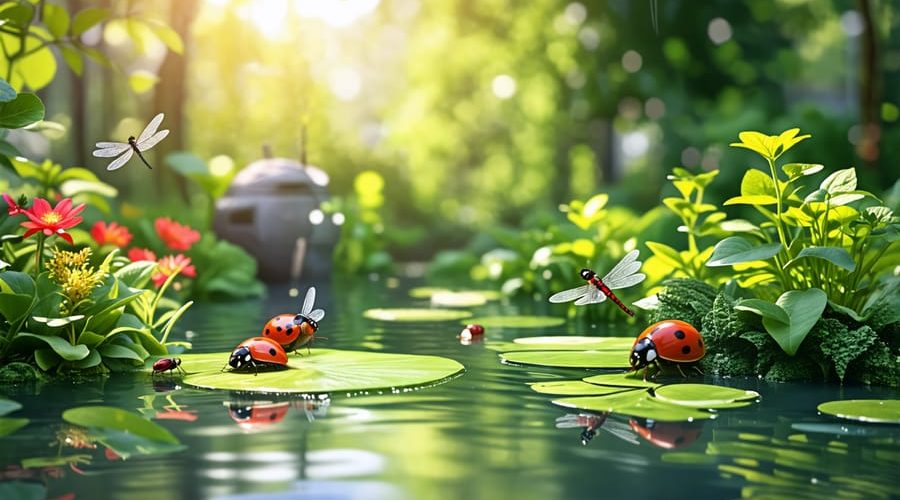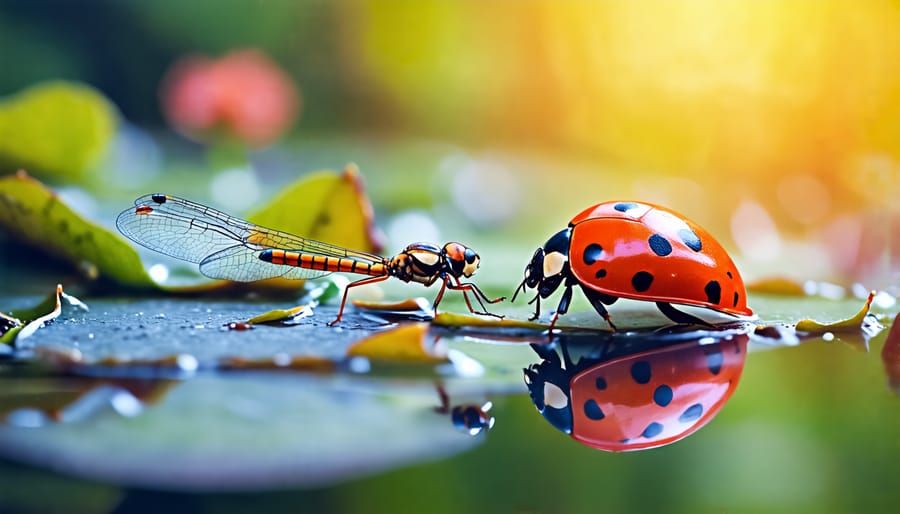
5 Pond-Friendly Pest Control Strategies to Keep Your Water Garden Thriving
Identify pests through careful observation of symptoms like damaged leaves, weak plant growth, or visible insects. Prevent infestations by maintaining good pond hygiene: regularly remove decaying organic matter, keep filters clean, and avoid overstocking fish. Employ biological controls like beneficial bacteria, nematodes, and predatory insects that naturally keep pest populations in check without harming desired pond life. Opt for mechanical removal and barriers before resorting to pesticides; handpick pests, prune affected foliage, and use row covers or sticky traps when appropriate.
Understanding Common Pond Pests

Identifying Pest Damage
Vigilant pond owners can spot the telltale signs of pest damage early on. Yellowing or curling leaves, wilting stems, and irregular holes in foliage often indicate insect feeding. Algal blooms, murky water, and sudden fish deaths may point to an underlying pest issue disrupting the ecosystem balance. Chewed edges on lily pads and other aquatic plants suggest larger pests like rodents or deer. Ripples on the water’s surface can reveal the presence of water boatmen or backswimmers. Keep an eye out for sticky residue on plants, a sign of scale insects or aphids. Regularly inspecting your pond’s plants, fish, and overall water quality helps catch pest problems before they escalate, allowing for swift and targeted control measures that minimize damage to your cherished water garden.
Pest Life Cycles and Habits
Understanding the life cycles and habits of common pond pests is crucial for developing effective control strategies. Most aquatic insects, such as mosquitoes and midges, lay eggs in standing water, which hatch into larvae that feed on organic matter before pupating and emerging as adults. Algae, while not true pests, can quickly overtake a pond if nutrients are abundant, blocking sunlight and depleting oxygen. Parasites like fish lice have complex life cycles involving multiple hosts, making them difficult to eradicate once established. Predatory insects like diving beetles and giant water bugs hunt smaller pond inhabitants, potentially disrupting the ecosystem’s balance. By understanding these unique characteristics, pond owners can better identify potential threats and implement targeted management techniques to maintain a thriving, pest-free water garden.
5 IPM Strategies for Water Gardens
1. Monitoring and Scouting
Regular monitoring is essential for spotting pest issues early in your water garden. Take time each week to closely inspect your plants, from the leaves and stems down to the root systems. Look for signs of damage like holes, discoloration, or wilting that could indicate an infestation. Don’t forget to check beneath the water surface too – many aquatic pests hide among the submerged foliage.
Keep a sharp eye out for the pests themselves, such as aphids clustered on new growth, Japanese beetles skeletonizing leaves, or mosquito larvae wriggling in the shallows. Using a magnifying glass can help you detect sneaky invaders before their populations explode.
Track your observations in a journal, noting the date, weather conditions, and specific pest sightings. Over time, patterns may emerge that reveal when certain pests typically arrive or which areas they target first. You can even snap photos to document what healthy plants look like versus struggling ones.
Think of monitoring as a relaxing, meditative part of your water gardening routine. Pour yourself a refreshing drink, put on some music, and commune with your pond as you scout for any unwelcome visitors. The more frequently and thoroughly you inspect, the faster you can nip potential problems in the bud!
2. Cultural Control Methods
Cultural control methods focus on maintaining a healthy pond ecosystem that naturally resists pest problems. Proper pond hygiene is essential – remove excess debris like fallen leaves and regularly clean filters to ensure optimal water quality. Avoid overfeeding fish, as uneaten food can decay and throw off the delicate balance of your pond’s healthy ecosystem.
Maintaining appropriate stocking levels prevents overcrowding, reduces fish stress, and minimizes waste buildup that can attract pests. Regularly inspect plants for signs of damage or disease and promptly remove any affected foliage to stop the spread.
Encouraging a diverse array of beneficial organisms like dragonflies, frogs, and predatory insects helps keep potential pests in check naturally. Planting a variety of native aquatic vegetation provides habitats for these helpful critters while competing with algae for nutrients.
Proper aeration is key – it supports beneficial bacteria, prevents stagnant conditions favored by many pests, and ensures a well-oxygenated environment for fish and plants to thrive. By creating a robust, self-sustaining ecosystem through attentive pond management practices, you can harness nature’s own defenses against common pest issues.

3. Physical and Mechanical Control
Physical and mechanical controls are effective non-chemical methods for removing or excluding pests from your water garden. Hand-picking insects, such as aphids or caterpillars, from plant foliage is a simple yet time-consuming approach. For larger ponds, consider using a fine mesh net to scoop out unwanted insects from the water surface. Installing physical barriers, like pond netting, can prevent birds from eating your fish and keep fallen leaves from accumulating in the water. Regularly cleaning your pond by removing debris, dead plant material, and algae helps eliminate hiding spots for pests and maintains good water quality. Pruning damaged or infested leaves from aquatic plants can also help control pest populations. Adding beneficial predators, such as ladybugs or lacewings, to your water garden can provide a natural form of pest control as they feed on common pond pests. Remember to monitor your pond closely and take action quickly when you spot signs of pest activity. With a combination of these physical and mechanical control methods, you can effectively manage pests in your water garden without relying on chemical treatments.
4. Biological Control Agents
Biological control agents harness the power of natural predators to keep pest populations under control in your water garden. Beneficial insects like ladybugs, lacewings, and parasitic wasps are voracious predators that feed on common pond pests such as aphids, mites, and caterpillars. To attract these helpful bugs, plant a diverse array of native flowers and herbs around your pond’s perimeter.
Bacteria can also be powerful allies in the battle against pond pests. Bacillus thuringiensis (Bt) is a naturally occurring soil bacterium that specifically targets mosquito and black fly larvae when applied to the water’s surface. It’s safe for fish, plants, and other aquatic life.
Dragonfly nymphs are another excellent biological control agent for water gardens. These aquatic predators devour mosquito larvae, helping to keep populations in check. Encourage dragonflies to take up residence by providing vertical plant stems as perches and avoiding pesticides that may harm them.
By fostering a balanced ecosystem rich in beneficial organisms, you can minimize pest issues and maintain a thriving, healthy pond environment. Regularly monitor your water garden to detect any imbalances and introduce biological controls as needed to restore harmony.

5. Least-Toxic Chemical Controls
When other management strategies prove insufficient, carefully selected chemical controls can be a last resort for treating stubborn pest issues in your pond. Always opt for the least-toxic, pond-safe pesticides that won’t harm your fish or beneficial plants. Before purchasing any product, thoroughly read the label to ensure it’s approved for aquatic use and won’t disrupt the delicate ecosystem balance.
When applying pond pesticides, follow the instructions precisely and avoid overuse, as excessive chemicals can lead to resistant pest populations and may harm non-target organisms. Consider spot-treating affected areas rather than broadcasting chemicals throughout the entire pond. Whenever possible, remove plants from the pond and treat them separately to minimize the risk of contamination.
Some common pond-safe pesticides include insecticidal soaps, horticultural oils, and Bacillus thuringiensis (Bt) products. These target specific pests while posing minimal risk to fish and plants when used as directed. After treatment, monitor your pond closely and perform water quality tests to ensure the chemicals haven’t caused any adverse effects.
Remember, the key to a thriving, pest-free pond lies in maintaining a healthy, balanced environment. By using chemical controls judiciously and only as a last resort, you can effectively manage pests while preserving the beauty and vitality of your water garden.
Conclusion
Implementing an integrated pest management plan for your water garden offers numerous benefits for the health and beauty of your pond. By taking a holistic approach that combines preventive measures, monitoring, and targeted control methods, you can effectively manage pest issues while minimizing the use of chemicals. Regular pond maintenance, such as removing debris and maintaining proper water quality, goes a long way in preventing pest problems from arising in the first place. When intervention is necessary, opting for pond-safe pesticides and biological controls helps maintain the delicate ecosystem of your water garden. By adopting IPM practices, you’ll not only save time and money in the long run but also create a thriving, sustainable environment that supports the diverse array of plants and wildlife in your pond. So embrace the power of integrated pest management and enjoy the rewards of a healthy, vibrant water garden that will be the envy of your neighborhood.
